Bee And Pollinator Declines
and Neonicotinoid Pesticides
The decline of pollinators is of real concern.
One group of pesticides called 'neonicotinoids' is the subject of great debate.
The aim of this page is to share just a small number of studies that have been carried out in this area.
However,
please note there are other factors of key concern in pollinator
decline. Habitat loss is a major factor, as mentioned elsewhere on this
site - see my link at the bottom of this page for further information.
Secondly, the following is in no way a representative sample of the information on this subject - this is just a few I have had the time to mention and write about. You can also get access to a very small number of papers by visiting my pesticide bibliography.
I also recommend you see this page about neonicotinoid myths and flawed arguments, as well as this general page about bee decline. At the bottom of this article are other links to information about neonicotinoids generally.
Missing Bees And Pollinator Declines - A Look At Some Studies
2005: J.M.Bonmatin et al: “Behaviour of Imidacloprid in
Fields. Toxicity for Honey Bees”. (Carried out for the French Ministries
of Agriculture and Environment).
Very early
on in the study, Bonmatin et al refer to the launch of Gaucho® onto the
market in 1994 for use on sunflowers. From 1995, beekeepers observed
numerous honey bee deaths, and that the problem worsened with the
increasing use of Gaucho® on maize. As a result, the product was
suspected of having a harmful effect on honey bees in fields. The
following graph indicates the decrease in honey production from 1994
onwards.
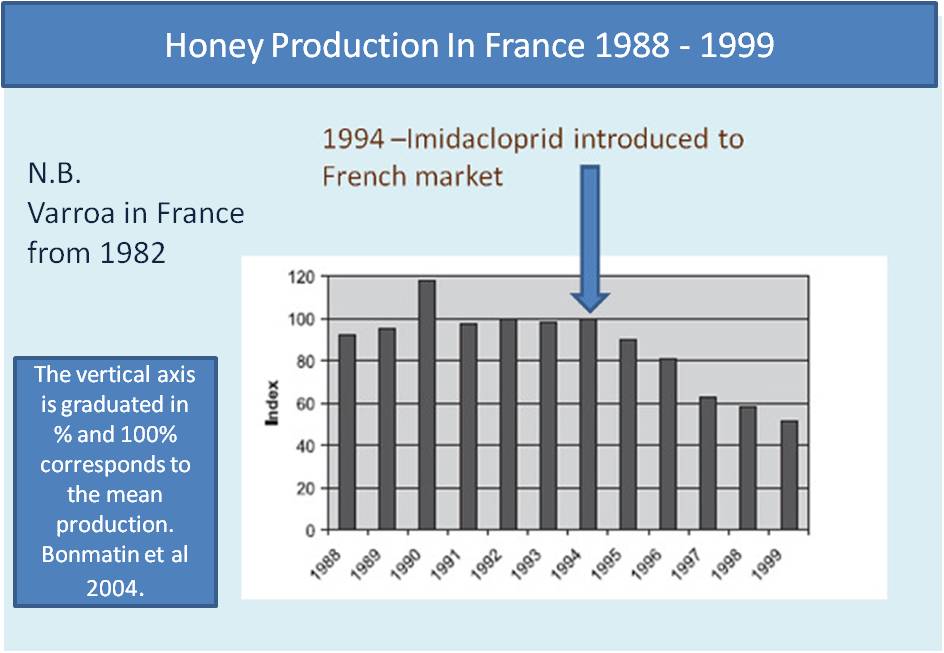
- This study investigates the availability of ‘sub-lethal’ doses
of imidacloprid to honey bees. It examines soils, plants and pollens. A
sub-lethal dose may cause effects which do not immediately kill, but rather it may impair or harm the functioning and may cause death in the longer term.
- The study referred to research by Suchail et al in 2001, and Belzunces 2001,
which revealed that concentrations as tiny as 0.1 to 1 microgram per
kilogram cause CHRONIC MORTALITY IN BEES (chronic mortality refers to a
condition of slow rather than immediate death).
Soils, plants
and pollens, were sampled throughout France and were analysed to follow
the fate of imidacloprid in the environment.
Soil Contamination
-
French soils from numerous areas with varying climates, soil
compositions and rain exposures were sampled - 74 in total, of which 7
came from known organic farms, and contained no imidacloprid. A total of
67 UNKNOWN soil samples were analysed. 91% of them contained
imidacloprid, and in 65% of these samples, the quantity of imidacloprid
was at more than 1 microgram per kilogram.
- Bonmatin et al
found that even where plants had not been treated with imidacloprid, but
were cultivated in soil where imidacloprid had been used on seeds one
or two years previously, imidacloprid was present in 97% of these soils,
with concentrations at 1.2 – 2 microgram per kilogram in 78% of those
samples.
- It discussed how levels of imidacloprid could build up
in soil after repeated use, so that accummulation effects could not be
excluded.
Why is this relevant? – Plant Contamination with Imidacloprid
The study found that residues of imidacloprid were taken up from the soil by sunflowers as they grew.
Even
when sunflower seeds had not been treated with imidacloprid, they were
observed to pick up the pesticide from the soil, and then became
available to bees at an average concentration of 1-2 micrograms per
kilogram.
- It was observed that imidacloprid became available
to bees through the flowering heads of the sunflowers, and that the
concentration increases during flowering. Indeed, when sunflowers were
treated with the authorised dose of imidacloprid (Gaucho®), the quantity
of imidacloprid found in the flower heads ranged from 2.5 – 9 microgram
per kilogram, with the final amount accessible to bees in the flower
heads ranging from 1 – 10 microgram per kilogram.
- Bonmatin et
al state that a similar phenomenon had been noted in maize, and several
weeds and to a lesser extent in wheat, barley and rape (Bonmatin et al
2000).
- Interestingly, the study also makes reference to research by Bayer Cropscience scientists (Placke & Weber 1993),
which indicated there were no traces of imidacloprid in sunflowers that
were raised from Gaucho® (Imidacloprid) dressed seeds. However,
Bonmatin et al make the point that the methods used by Bayer only
allowed quantification from 20-50 microgramms per kilogram, whilst
neglecting to measure levels lower than this, but that have been found
to be toxic to bees.
Pollen Contamination
-
Samples of pollens from imidacloprid treated sunflowers were analysed.
58% of these samples contained concentrations of imidacloprid at levels
between 1 – 11 microgram per kilogram. 25% of the samples had
concentrations not exceeding 1 microgram per kilogram. They concluded
that pollens represent a way for toxins to contaminate bee hives.
- The study referred to similar testing techniques being used by Bayer AG (Schmuck et al 2001),
where indeed contamination of pollen and nectar had been recorded, but
again, they had set their limits of detection at less sensitive levels.
2009: V. Girolami et al; “Translocation of Neonicotinoid
Insecticides From Coated Seeds to Seedling Guttation Drops: A Novel Way
of Intoxication for Bees”. (Published: Entomological Society of
America).
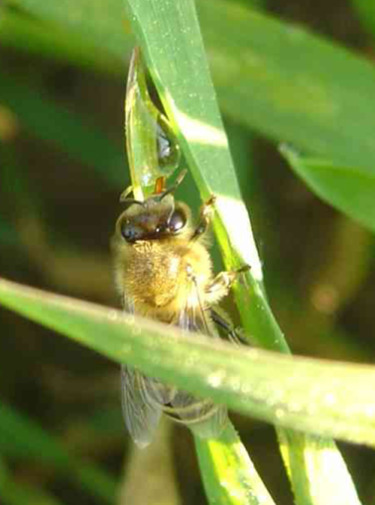
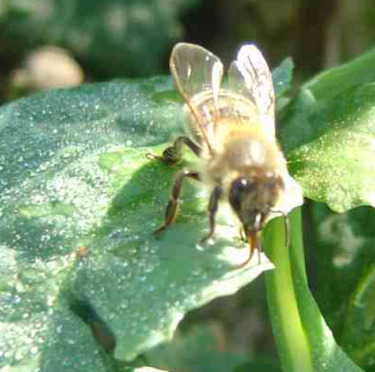
‘Guttation’ is a process where plants excrete their own xylem fluid from leaf margins and tips. Honey bees are known to drink from leaf guttations, including from plants where they are not foraging for nectar and pollen.
- The study states: “When bees consume guttation
drops collected from plants grown from neonicotinoid-coated seeds, they
encounter death within a few mintues”.
- Neonicotinoids
included within the research: Imidacloprid, Clothianidin, Thiamethoxam,
and also a non-neonicotinoid, systemic insecticide that works in a
similar way to neonicotinoids; Fipronil.
- The concentrations
identified to be secreted in guttation drops, and available to bees in
this study were higher than 10 milligrams per litre.
Following this research, Hedwig Riebe of the Deutscher Berufs und Erwerbs Imker Bund e. V. in 2009 (German Beekeepers Association),
presented information and photographic evidence from their own little
project. The pictures are featured left and below. Note, this was not a
scientific, peer-reviewed study.
Hives were placed in an 8
ha canola field in Dueren, Germany, where canola crops and those around
them, were treated with the neonicotinoid, clothianidin.
Photographic
evidence was taken. The study states that bees were seen collecting
from guttation drops, even when puddles were available, although there
were also water collectors observed in the field tyre tracks where water
formed puddles, up to 40m from the hives.
- Photographic evidence was also recorded showing the resulting honey
bee deaths, with images of dead bees outside the front of the hive at
7.30am.....
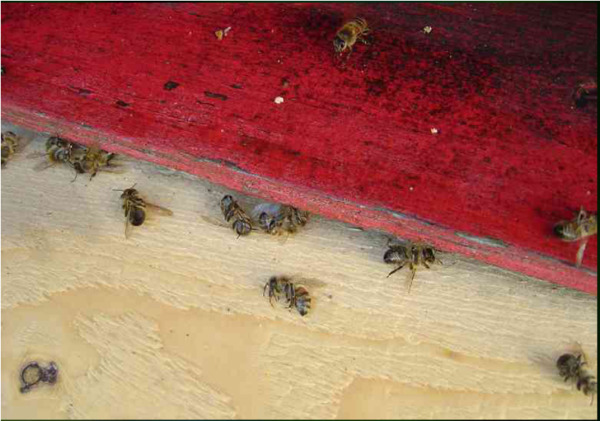
...and at 12.20 - more honey bee deaths at the hive.
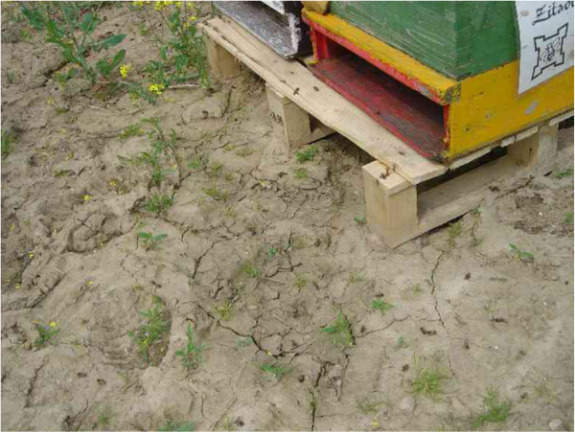
M.E. Colin, J. M. Bonmatin, I. Moineau, C. Gaimon, S. Brun,
J.P. Vermandere: A Method to Quantify and Analyze the Foraging Activity
of Honey Bees: Relevance to the Sublethal Effects Induced by Systemic
Pesticides”. 2004. (Environmental Contamination in Toxicology).
- They tested both Imidacloprid and Fipronil, using dose levels 70 TIMES LOWER than the 50% lethal dose concentration.
- The study found that at sub-lethal doses, the ability of honey bees to forage was severly impaired.
-
The study stated that sub-lethal effects induced by systemic
insecticides should be considered in risk assessment schemes when
considering beneficial insects such as honey bees.
Henk A. Tennekes: The significance of the Druckrey–Küpfmüller
equation for risk assessment—The toxicity of neonicotinoid insecticides
to arthropods is reinforced by exposure time. Toxicology 2010.
Also: a book published, the website for which can be found here (opens a new window)
“A Disaster in the Making”.
Tennekes says the Druckrey-Küpfmüller equation tells us that
very low doses or concentrations of some compounds can have devastating
effects in the long run. He concludes that even minute quantities can be
harmful to insects.
In addition, in a separate presentation, he wrote:
“Neonicotinoids bind irreversibly to critical receptors in the central nervous system of insects and cause irreversible effects.
The damage is cumulative, and with every exposure more receptors are blocked. In fact, there may not be a safe level of exposure.
Neonicotinoids account for worker bees neglecting to provide food for eggs and larvae, and for a breakdown of the bees' navigational abilities. Bees, the number one insect pollinator on the planet, are dying at an alarming rate. Neonicotinoids are prone to leach from soils and contaminate ground and surface water.
Not only are they water soluble and mobile in soil, they are also quite persistent in soil and water. Imidacloprid pollutes Dutch surface water. Ground and surface water contamination with persistent insecticides that cause irreversible damage to non-target insects is an environmental disaster in the making.
The imidacloprid pollution of surface water in Western Dutch provinces with intensive agriculture has already been associated with insect decline and a dramatic decline of common grassland birds.”
– From a presentation by Tennekes.
There are also links to his book available on Lulu on my page featuring
a review of Dr Tennekes' book.
Greatti et al: Risk of Environmental contamination by the
active ingredient imidacloprid used for corn seed dressing. Bulletin of
Insectology 2003.
This study suggests there may be
environmental contamination by imidacloprid of flowers and grass (due to
air contamination) near corn fields during seed sowing operations, and
in a manner that could cause damage to bee colonies.
Could methods of application of pesticides be an added factor resulting in missing bees - and especially our wild bees?
Maini et al: The Puzzle of Honey Bee Losses – A Brief Overview. Bulletin of Insectology 2010-11-27
-
Remarks are made about divided opinion on the impact of pesticides on
bees, for example, scientists funded by pesticide companies versus
opinion of beekeepers and environmentalists.
- The paper states:
"It is impossible to ‘demonstrate scientifically’ the direct influence
that the pesticide corporations, seed companies, and some farm lobbies,
have on research teams that conduct research on honey bees – especially
that related to CCD. There are several international and national
projects investigating CCD, examples include COLOSS and APENET,
respectively. Globally many other projects are beingcarried out, while
some of these are sponsored by publicfunding, others are supported by
the pesticide corporations.In the latter case, are the scientific
results and hypothesis influenced?"
- Maini et al submitted a critical manuscript of a paper by Nguyen et al 2009, to the Journal of Apicultural Research (a publication of the UK-based International Bee Research Association – IBRA).
This
paper was a critique of Nguyen et al's assertions that imidacloprid
seed-treated maize had no negative impact on honey bees – it failed to
take account of a number of prominent research studies that suggest
otherwise, whilst drawing on research from industry scientist, notably Maus et al, representing Bayer Cropscience.
- Six months later, Prof Norman Carreck, senior editor of the Journal of Apicultural Research, rejected the paper submitted by Maini.
If you found this page helpful or interesting, I'd really be grateful if you would share it with others - if not this page, perhaps another, such as Gardening For Bees.
Thank you so much :) .